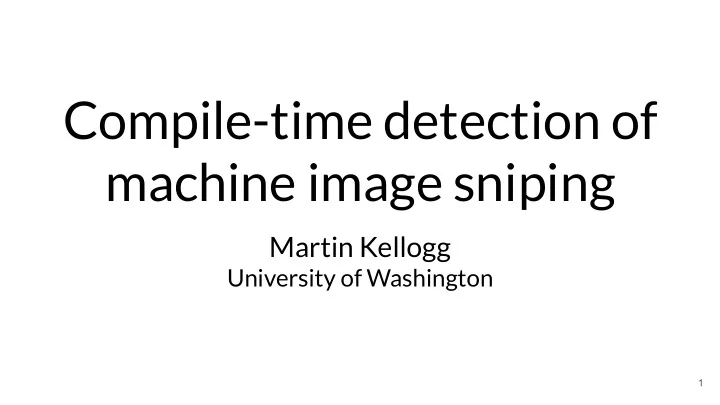

Compile-time detection of machine image sniping Martin Kellogg University of Washington 1
What is a machine image? cloud computer 2
What is a machine image? What software to run? cloud computer 3
What is a machine image? What software to run? cloud computer “machine image” 4
What is a machine image? What software to run? This software! cloud computer “machine image” 5
How to choose a machine image: Look it up in a repository. By unique id: ● aws ec2 describe-images --imageIds ami-5731123e By owner and name: ● aws ec2 describe-images --owners myOrg \ --filters "Name=name,Values=ubuntu16.04-*" By name alone: ● aws ec2 describe-images \ --filters "Name=name,Values=ubuntu16.04-*" 6
How to choose a machine image: Look it up in a repository. By unique id: ● aws ec2 describe-images --imageIds ami-5731123e By owner and name: ● aws ec2 describe-images --owners myOrg \ --filters "Name=name,Values=ubuntu16.04-*" By name alone: ● aws ec2 describe-images \ --filters "Name=name,Values=ubuntu16.04-*" 7
How to choose a machine image: Look it up in a repository. By unique id: ● aws ec2 describe-images --imageIds ami-5731123e By owner and name: ● aws ec2 describe-images --owners myOrg \ --filters "Name=name,Values=ubuntu16.04-*" By name alone: ● aws ec2 describe-images \ --filters "Name=name,Values=ubuntu16.04-*" 8
How to choose a machine image: Look it up in a repository. By unique id: ● aws ec2 describe-images --imageIds ami-5731123e By owner and name: ● aws ec2 describe-images --owners myOrg \ --filters "Name=name,Values=ubuntu16.04-*" By name alone: ● aws ec2 describe-images \ X --filters "Name=name,Values=ubuntu16.04-*" 9
This isn’t hypothetical... 10
This isn’t hypothetical... 11
This isn’t hypothetical... DescribeImagesRequest request = new DescribeImagesRequest (); request. withFilters ( new Filter ("name", "RHEL-7.5_HVM_GA")); api. describeImages (request); 12
This isn’t hypothetical... DescribeImagesRequest request = new DescribeImagesRequest (); request. withFilters ( new Filter ("name", "RHEL-7.5_HVM_GA")); X api. describeImages (request); 13
This isn’t hypothetical... DescribeImagesRequest request = new DescribeImagesRequest (); request. withFilters ( new Filter ("name", "RHEL-7.5_HVM_GA")); X api. describeImages (request); Unsafe: returns all images with that name from public repo! 14
How to make this client safe? DescribeImagesRequest request = new DescribeImagesRequest (); request. withFilters ( new Filter ("name", "RHEL-7.5_HVM_GA")); api. describeImages (request); 15
How to make this client safe? DescribeImagesRequest request = new DescribeImagesRequest (); request. withFilters ( new Filter ("name", "RHEL-7.5_HVM_GA")); request. withOwners (“myOrg”); api. describeImages (request); 16
How to prove this safe? 17
How to prove this safe? A traditional approach: typestate 18
How to prove this safe? A traditional approach: typestate * withImageIds() * withOwners() * 19
How to prove this safe? A traditional approach: typestate ● create a finite state machine for each object ● on method calls, transition the state machine ● only permit certain calls in certain states ● use alias analysis to ensure all copies are in same state 20
How to prove this safe? A traditional approach: typestate ● create a finite state machine for each object ● on method calls, transition the state machine ● only permit certain calls in certain states ● use alias analysis to ensure all copies are in same state 21
Advantages of a type system ● still provides a proof ● modular ⇒ scalable ● no alias analysis ⇒ cheap 22
Specifying describeImages() DescribeImageResponse describeImages ( @CalledMethods ("withImageIds || withOwners") DescribeImageRequest request) { … } 23
Type hierarchy @CalledMethods({}) Object @CalledMethods({“foo”}) Object @CalledMethods({“foo”, “bar”}) Object 24
Experimental results No. projects 548 Source LoC 9.2M True positives 14 False positives 3 25
Example: Netflix/SimianArmy public List < Image > describeImages ( String ... imageIds) { DescribeImagesRequest request = new DescribeImagesRequest(); if (imageIds != null ) { request. setImageIds ( Arrays . asList (imageIds)); } DescribeImagesResult result = ec2client. describeImages (request); return result. getImages (); } 26
Accumulation analysis ● Our type system accumulates method calls 27
Accumulation analysis ● Our type system accumulates method calls Insight: can generalize to any analysis that accumulates something 28
Accumulation analyses ● machine sniping (this talk!) 29
Accumulation analyses ● machine sniping (this talk!) ● the builder pattern 30
Accumulation analyses ● machine sniping (this talk!) ● the builder pattern ● dependency injection providers 31
Contributions ● Accumulation analysis can detect machine-image sniping vulnerabilities -- and more ● Experiments that show: ○ those vulnerabilities exist in practice, and ○ we can find them! 32
33
Lombok/AutoValue builders Lombok and AutoValue generate builder implementations from structs Fields can be marked @NonNull; NPE if the corresponding setter isn’t called 34
Lombok/AutoValue builders @Builder public class UserIdentity { private final @NonNull String name; private final @NonNull String displayName; private final @NonNull ByteArray id; } 35
Lombok/AutoValue builders UserIdentity identity = UserIdentity . builder () . name (username) . displayName (displayName) . id ( generateRandom (32)) . build (); 36
Lombok/AutoValue builders UserIdentity identity = UserIdentity . builder () . name (username) . displayName (displayName) . id ( generateRandom (32)) . build (); 37
Lombok/AutoValue builders UserIdentity identity = UserIdentity . builder () . name (username) //. displayName (displayName) . id ( generateRandom (32)) . build (); 38
Lombok/AutoValue builders UserIdentity identity = UserIdentity . builder () . name (username) X //. displayName (displayName) . id ( generateRandom (32)) . build (); 39
Lombok user study 6 industrial developers with Java + Lombok experience Task: add a new @NonNull field to a builder, and update all call sites Results: ● 6/6 succeeded with our tool, only 3/6 without ● Those who succeeded at both 1.5x faster with our tool ● “It was easier to have the tool report issues at compile time” 40
Lombok/AutoValue case studies 5 projects: 2 Lombok, 3 AutoValue (~500k sloc) 563 calls verified, 1 true positive (google/gapic-generator) 110 annotations, 19 false positives 41
Recommend
More recommend